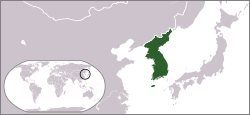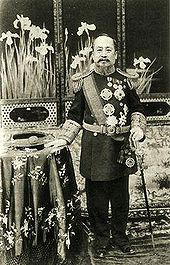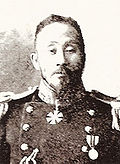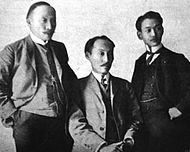- Korean Empire
-
Greater Korean Empire
대한제국
大韓帝國
Daehan-jeguk← 
1897–1910  →
→
 →
→

Taegeukgi Imperial Seal Motto
광명천지
(Hanja: 光明天地)
(English: Let there be light across the land)Anthem
대한 제국 애국가
(tr.: Daehan Jeguk Aegukga)
(English: Anthem of the Greater Korean Empire)Territory of Korean Empire Capital Gyeongseong
(now Seoul, South Korea)Language(s) Korean Government Absolute monarchy with constitution Emperor - 1897–1907 Gojong - 1907–10 Sunjong Premierb - 1894–96 Kim Hongjip - 1897–1898 Yun Yong-seon - 1905 Han Gyu-seol - 1905-1907 Pak Jesun - 1907–1910 Lee Wan-Yong Historical era New Imperialism - Empire proclaimed October 13, 1897 - Constitution August 17, 1899 - Eulsa Treaty November 17, 1905 - Hague Secret Emissary Affair 1907 - Annexed by Japan August 29, 1910 - Independence declared March 1, 1919 Population - 1907 est. 13,000,000 Currency Won (원;圓) a Unofficial b 총리대신 (總理大臣) later changed name to 의정대신 (議政大臣) in 1905, and renamed 총리대신 in 1907. History of Korea 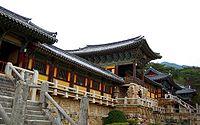
This article is part of a seriesPrehistory Jeulmun period Mumun period Gojoseon ?–108 BCE Wiman Joseon 194 BCE–108 BCE Proto–Three Kingdoms 300–57 BCE Buyeo, Goguryeo, Okjeo, Dongye Jin state, Samhan (Ma, Byeon, Jin) Four Commanderies of Han Three Kingdoms 57 BCE–668 Goguryeo 37 BCE–668 Baekje 18 BCE–660 Silla 57 BCE–935 Gaya 42–562 North and South States 698–926 Unified Silla 668–935 Balhae 698–926 Later Three Kingdoms 892–936 Taebong, Hubaekje, Silla Goryeo Dynasty 918–1392 Joseon Dynasty 1392–1897 Korean Empire 1897–1910 Colonial Korea 1910–1945 Provisional Gov't 1919–1948 Division of Korea 1945–present North, South Korea 1948–present By topic Timeline List of monarchs Linguistic history Science and technology history Art history Military history Naval history
Korea Portal
The Greater Korean Empire (Korean: 대한제국, hanja: 大韓帝國) was an empire of Korea that succeeded the Joseon Dynasty.
In October 1897, Emperor Gojong proclaimed the new entity at Gyeongungung Palace and oversaw the partially successful modernization of the military, economy, land system, education system, and various industries. However, it was not a radical reform, and Korea steadily become subordinated to the larger powers of Japan and Russia. On August 22, 1910, Korea was annexed by Imperial Japan, which defeated the Russian power in 1905.
Contents
History
Background
The Sino-Japanese War marked the rapid decline of any power the Joseon Dynasty of Korea had managed to hold against foreign interference, as the battles of the conflict itself had been fought on Korean soil and the surrounding seas. With its newfound preeminence over the waning and weak Qing Dynasty, Japan had delegates negotiate the Treaty of Shimonoseki with the Qing emissaries, through which Japan wrested control over the Liaodong Peninsula from the Qing (a move designed to prevent the southern expansion of Japan's new rival, Russia), and, more importantly to Korea. However, Russia recognized this agreement as an act against its interests in northeastern China and eventually brought France and Germany to its side in saying that the Liaodong Peninsula should be repatriated to the Qing China.
At the time, Japan was powerless to resist such foreign pressure, especially by nations that it considered far more advanced and which it sought to emulate, and as such relinquished its claim to the Liaodong Peninsula. With the success of the three-country intervention, Russia emerged as another major power in East Asia, replacing the Qing Dynasty as the entity that the Joseon court's many government officials advocated close ties with to prevent more Japanese meddling in Korean politics. Queen Min (later became Empress Myeongseong), the consort of King Gojong, also recognized this change and formally established closer diplomatic relations with Russia to counter Japanese influence.
Queen Min began to emerge as a key figure in higher-level Korean counteraction against Japanese influence. Japan, seeing its designs endangered by the queen, quickly replaced its ambassador to Korea, Inoue Kaoru, with Miura Goro, a diplomat with a background in the Japanese military. It is widely known that he orchestrated the assassination of Queen Min on October 8, 1895, at her residence at the Geoncheong Palace, the official sleeping quarters of the king within Gyeongbok Palace.[citation needed]
Proclamation of Empire
With the assassination of his wife Empress Myeongseong, King Gojong and Crown Prince (later became Emperor Sunjong) fled to the Russian legation in 1896. During the time from Queen Min's death to the king's return from Russian protection, Korea underwent another major upheaval both at home and abroad. By 1894, new laws passed by pro-Japanese progressives in the royal cabinet forced through long-desired reforms aimed at revamping Korea's antiquated society. These laws were called the Gabo Reforms referring to the year (1894) in which they began.[1]
Meanwhile, the new reforms aimed at modernizing Korean society soon attracted controversy from within. Anti-Japanese sentiment, which had already become entrenched in the minds of commoners and aristocrats alike during the Japanese invasions of Korea (1592–1598), became pervasive in the royal court and upper echelons of society following the Ganghwa Treaty of 1876 and soon extended explosively to most Koreans following perceived Japanese meddling in court politics and the assassination of Empress Myeongseong. However, the new and modern reforms pushed forward by the pro-Japanese progressives, the most controversial of which was the mandatory cutting of male hair buns (it was a tradition in Korea), ignited further resentment and discontent. This led to the uprising of the Eulmi temporary armies aimed at avenging the assassination of Empress Myeongseong.
In 1896, Seo Jae-pil, a naturalized citizen of the United States and the man behind the Tongnip Sinmun (독립 신문), or the "Independent Newspaper", formed the so-called Independence Club (독립 협회) in cooperation with progressives who desired autonomy from external influences, mainly of that of Japan. The Independence Association, once limited as an organized movement that was led by and included only government officials, soon expanded to include civilians from all classes. The Independence Association stressed the need for a reform-oriented government policy that would eventually lead to full independence. The association also regularly held conferences to strengthen national morale. It collected money to continue the issuance of regular editions of the Independent Newspaper and to demolish the Yeongeunmun Gate and construct the Independence Gate at that very site.
In 1897, King Gojong, yielding to rising pressure from both overseas and the demands of the Independence Association-led public opinion, returned to Gyeongungung (modern-day Deoksugung). There, he proclaimed the founding of the Empire of Korea, officially redesignated the national title as such, and declared the new era name Gwangmu (Hangul: 광무, Hanja: 光武) (meaning warrior of light), effectively severing Korea's superficial historic ties as a tributary of Qing Dynasty, which Korea had adhered to since the prior Manchurian invasion in 1636. King Gojong became the Gwangmu Emperor, the first imperial head of state and hereditary sovereign of the Empire of Korea. This marked the complete end of the old world order and traditional amicable dependency system in the Far East. Korea's new status as an empire meant "Completely independence from Qing's sphere of influence" which means Korea was not influenced from Qing externally according to the Treaty of Shimonoseki of 1895 and also implemented (at least nominally) the "full and complete" independence according to the treaty.
The name, meaning "Great Han Empire," was chosen to indicate the revival of the Samhan confederacies of the Proto–Three Kingdoms of Korea, in the tradition of naming new states after historic states (Gubon Sincham, 舊本新參, 구본신참).
Westernization policy during the Korean Empire
Background
A group of Korean officials and intellectuals felt great necessity of the comprehensive reform of the country, after the observation tour of other modernized countries. More and more intellectuals were informed of the Western civilization and became conscious of the modernized powerful nations of Europe and Western Asia. Later, the progressives within the group initiated The Gabo Reform in 1894 and the moderate reformists carried out the Gwangmu Reform during the Great Korean Empire.
American missionaries, who had close relationships with the Korean royal court, also helped the propagation of Western culture. Under royal finance and support, American missionary doctor Horace N. Allen introduced Western medicine by establishing Gwanghyewon, what would become Severance Hospital and the oldest Western-style hospital in Korea. Additionally, the missionaries provided Western education for Korean girls, who had previously been excluded from the educational system.
Gwangmu Reform
 The office building of the Seoul Electric Company.
The office building of the Seoul Electric Company.
During Gwangmu period, Western-style official uniforms were introduced in Korea. At the start, the Korean Emperor had begun to wear Prussian-style royal attire along with Korean diplomats, who wore Western suits. In 1900, Western attire became the official uniform for the Korean civil officials. Several years later, all Korean soldiers and policemen were assigned to wear Western uniform.
In the military sphere, the Korean army as it existed in the early 1890s consisted of about 5,000 soldiers, but was, according to one contemporary British assessment, "badly armed, drilled, clothed, and fed" and thus "practically useless".[2] Yet training by Russian officers beginning in 1896 led to the organization of a 1,000-strong royal bodyguard armed with Berdan rifles that served as the core of an improved army. From this core unit, soldiers were sometimes transferred to other units, which included five regiments of about 900 men each.[3]
In 1897, the cadastral survey project was launched by the Gwangmu government, aiming at modernizing the landownership system. In order to apply Western surveying methods, American surveyors were hired. After the survey, a property title “Jigye”, showing the exact dimension of the land, were supposed to be issued by the authorities concerned. That reform was closely involved to the reform of land tax system, which was conducted under the leadership of Yi Yong-ik, who also carried out the monetary reforms in Korea. The project was interrupted owing to the Russo-Japanese war in 1904–1905, after having finished about two-thirds of the whole land.
In that time, modern urban infrastructures were built by the Gwangmu government. In 1898, Gwangmu Emperor authorized the creation of a joint venture with American businessmen. In consequence, Hanseong Electric Company, operating a public electrical lightning network and an electric streetcar system was founded. And Seoul Fresh Spring Water Company had an American connection as well. In 1902, six years after the first introduction of telephone in Korea, the first long-distance public phone was installed.
During the Gwangmu period, the industrial promotion policy was also conducted by the Korean government. It gave support to found technical and industrial schools. In that time, along with modernized weaving factories which were established to meet demand for textiles on domestic market, technological innovations in the field of weaving industry were occurred in Korea. For instance, spinning and weaving machines were made for producing silk, so as to be substituted for high-cost machines from abroad.
However, Gwangmu Reform was not a radical because of foreign liabilities, suppression of democracy, and slow pace of that. As a result, Korea was sandwiched between struggle of Japan and Russia.
Subsequent developments
On August 22, 1904, the first treaty between Japan and Korea, known as First Japan-Korea Convention, was signed. The Taft-Katsura Agreement (also known as the Taft-Katsura Memorandum) was issued on July 17, 1905, and was not actually a secret pact or agreement between the US and Japan, but rather a set of notes regarding discussions on US-Japanese relations between members of the governments of the United States and Japan.[4] The Japanese Prime Minister Katsura Taro used the opportunity presented by Secretary of War William Howard Taft's stopover in Tokyo to extract a statement from (representative of the Roosevelt Administration) Taft's feeling toward the Korea question.[5] Taft expressed in the Memorandum how a suzerain relationship with Japan guiding Korea would "contribute to permanent peace in the Far East".[5]
In September 1905, Russia and Japan signed the Treaty of Portsmouth ending the Russo-Japanese War and firmly establishing Japan's consolidation of influence on Korea. Secret diplomatic contacts were sent by the Gwangmu Emperor in the fall of 1905 to entities outside of Korea presenting Korea's desperate case to preserve their sovereignty because normal diplomatic channels were no longer an option due to the constant surveillance by the Japanese.[6]
On November 17, 1905 the Eulsa Treaty (known also as "1905 Agreement", "The Five Article Treaty" or "Second Japan-Korean Convention") was signed in Korea even before Dr. Homer Hulbert's mission entered Washington. Reportedly, the seal of the Korean Foreign Ministry was snatched and pressed on the document which had been prepared by the Japanese. One week after the forced "treaty" the State Department withdrew its US legation from Korea even before Korea notified the US of their new "protectorate" status.[7]
The empire began with the law and perception of the international system at the time stacked against what was a slowly modernizing country. In the end, a weak and unmodernized military, the lack of a clear concept of sovereignty, and the remaining legacy of Korea's suzerain relationship with Qing held Korea back from fending off foreign encroachment. Eventually the Gwangmu Emperor was forced to abdicate in 1907 in favor of his son, Emperor Sunjong, who became the second and last emperor of the Empire of Korea, due to his attempt to send delegates to the Hague Peace Conference (Hague Convention of 1907) in violation of the arbitrarily implemented Eulsa Treaty. The delegation at The Hague was led by Yi Sang-seol and his deputy Yi Jun, Yi Wi-jong presented a diplomatic attempt to reclaim the Empire's sovereignty. Although Korea pleaded its case to the powerful members of colonial elite nations at The Hague, the view of protectorate status of Japan from the growing Japanese influences over Korea seemed natural and beneficial at the height of colonialism in the first decade of the twentieth century to the Westerners.
On August 22, 1910, the Korean Empire was annexed by Japan with the forced Japan-Korea Annexation Treaty, beginning a 35-year period of Japanese colonial rule which stripped Korea's sovereignty.
Prior to the Korean Empire, several dynastic rulers of Gojoseon, Buyeo, Goguryeo, Silla, Baekje, Balhae and Goryeo claimed the right to imperial status and used imperial titles at one time or another.
Diplomatic relationship
- Empire of Japan: 1876-1910
- United States: 1882-1905
- British Empire: 1882-1905
- German Empire: 1883-1905
- Kingdom of Italy: 1884-1905
- Russian Empire: 1884-1905
- French Third Republic: 1886-1905
- Austria-Hungary: 1892-1905
- Qing China: 1899-1905
- Kingdom of Belgium: 1901-1905
- Kingdom of Denmark: 1902-1905
Notes
- ^ Pratt, Keith (1999). Korea: A Historical and Cultural Dictionary. p. 194.
- ^ Keltie, J.S., ed. The Statesman's Year Book: Statistical and Historical Annual of the States of the World for the Year 1900. New York: MacMillan, 1900. p 791. (Retrieved via Google Books 3/3/11.)
- ^ Keltie 1900, p. 791.
- ^ Nahm, Andrew. "The impact of the Taft-Katsura Memorandum on Korea: A reassessment," Korea Journal. October 1985, p. 9.
- ^ a b Nahm, p. 10.
- ^ Kim, Ki-Seok, "Emperor Gwangmu’s Diplomatic Struggles to Protect His Sovereignty before and after 1905," Korea Journal, (Summer 2006). p. 239.
- ^ Kim, p. 245.
See also
- List of Korea-related topics
- List of Korean monarchs
- Yi royal family
- Joseon Dynasty
References
- Pratt, Keith L., Richard Rutt, and James Hoare. (1999). Korea: a historical and cultural dictionary, Richmond: Curzon Press. 10-ISBN 0700704639/13-ISBN 9780700704637; 10-ISBN 0700704647; 13-ISBN 9780700704644; OCLC 245844259
External links
Categories:- Former countries in East Asia
- Former empires
- States and territories established in 1897
- States and territories disestablished in 1910
- Korean Empire
Wikimedia Foundation. 2010.

